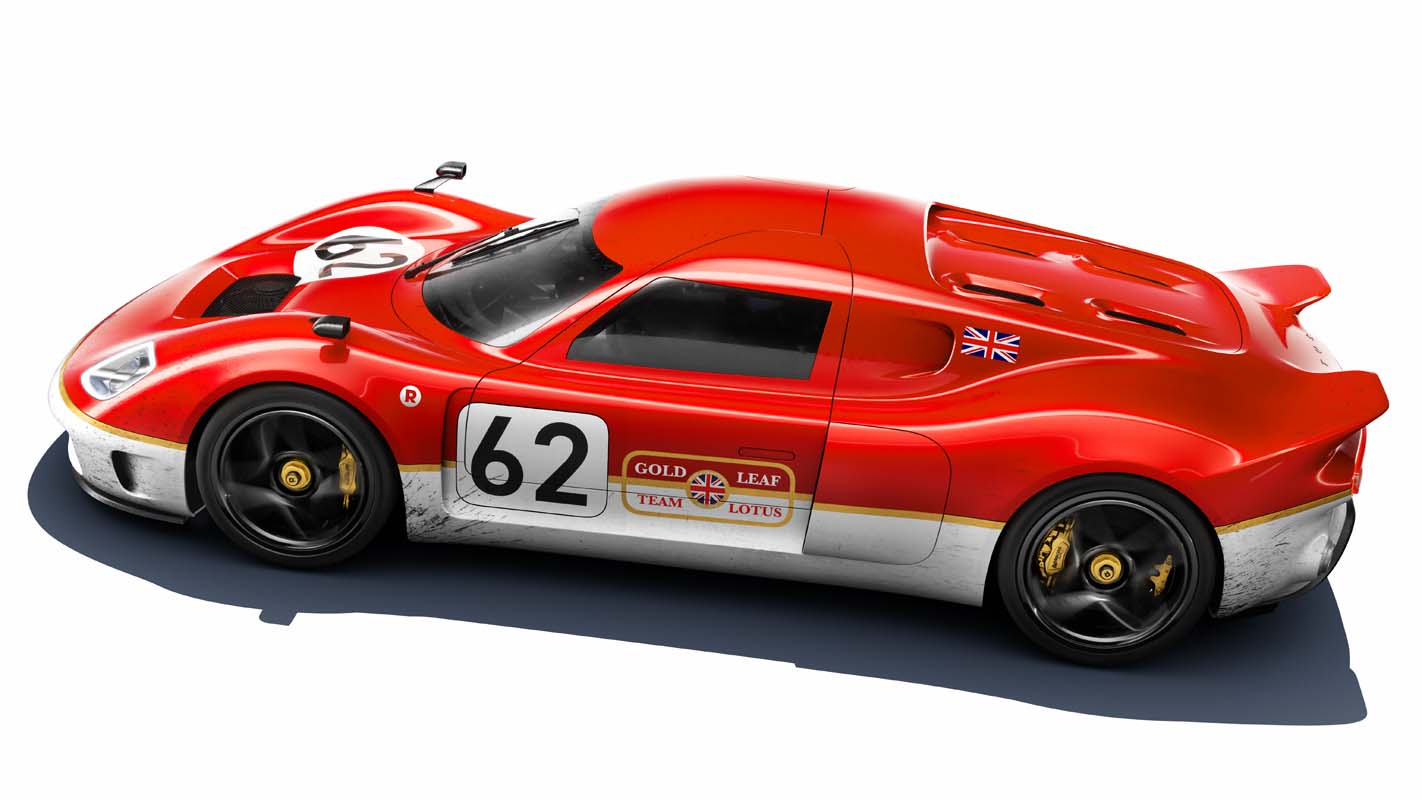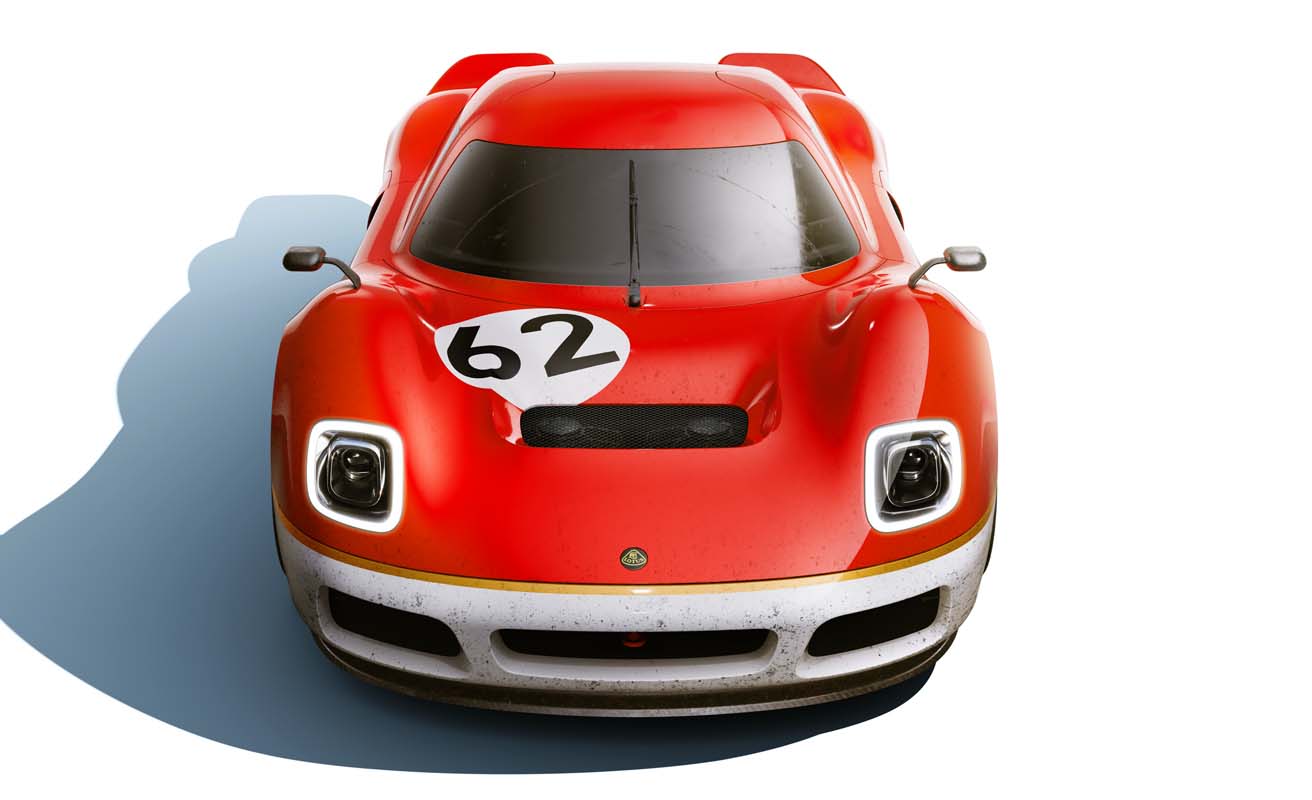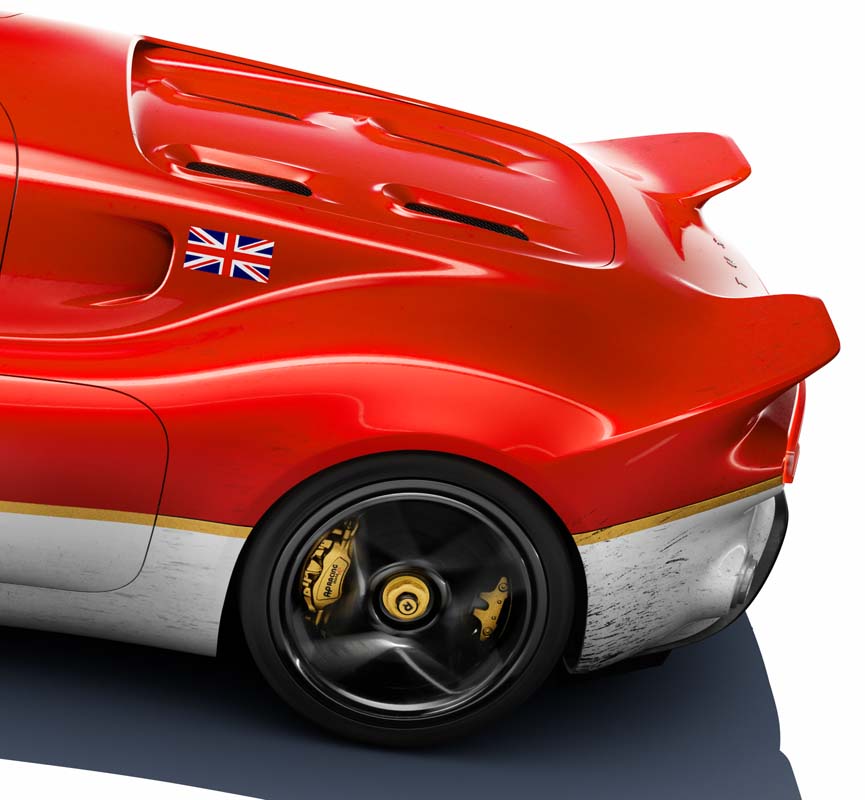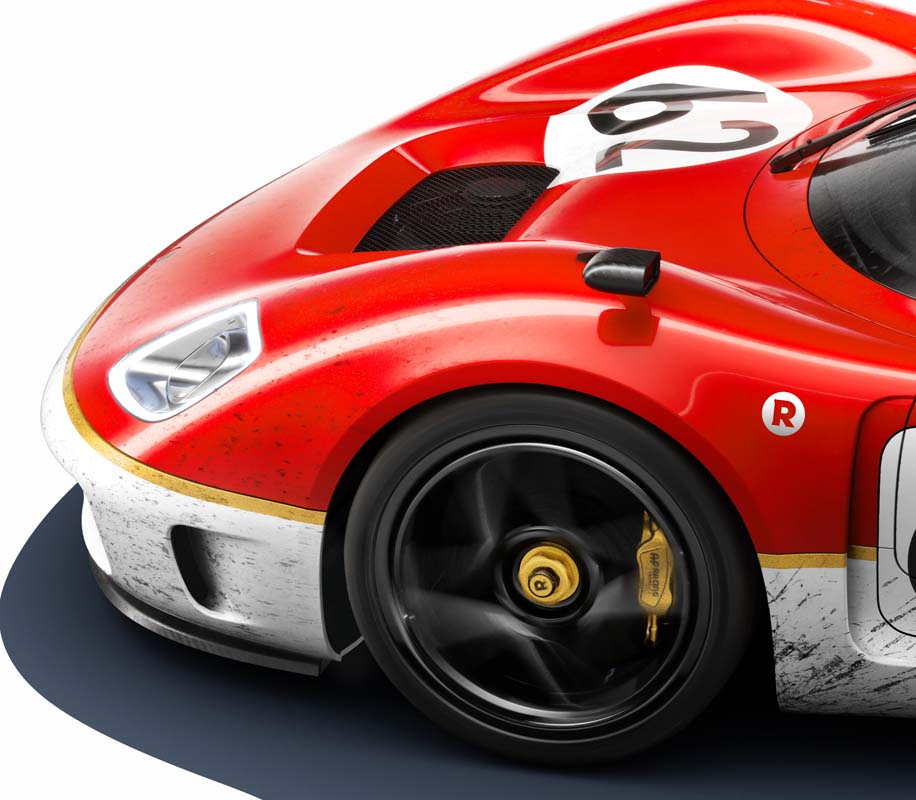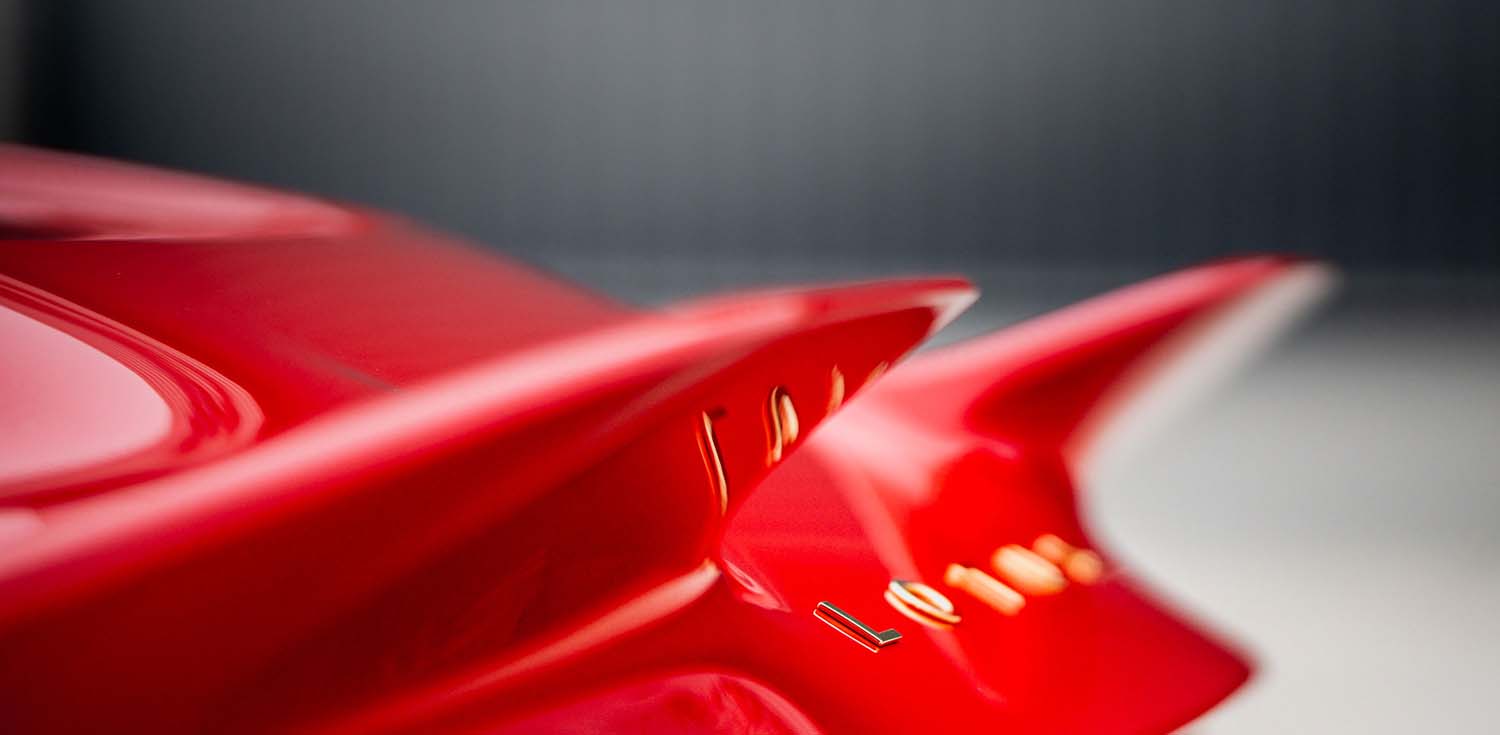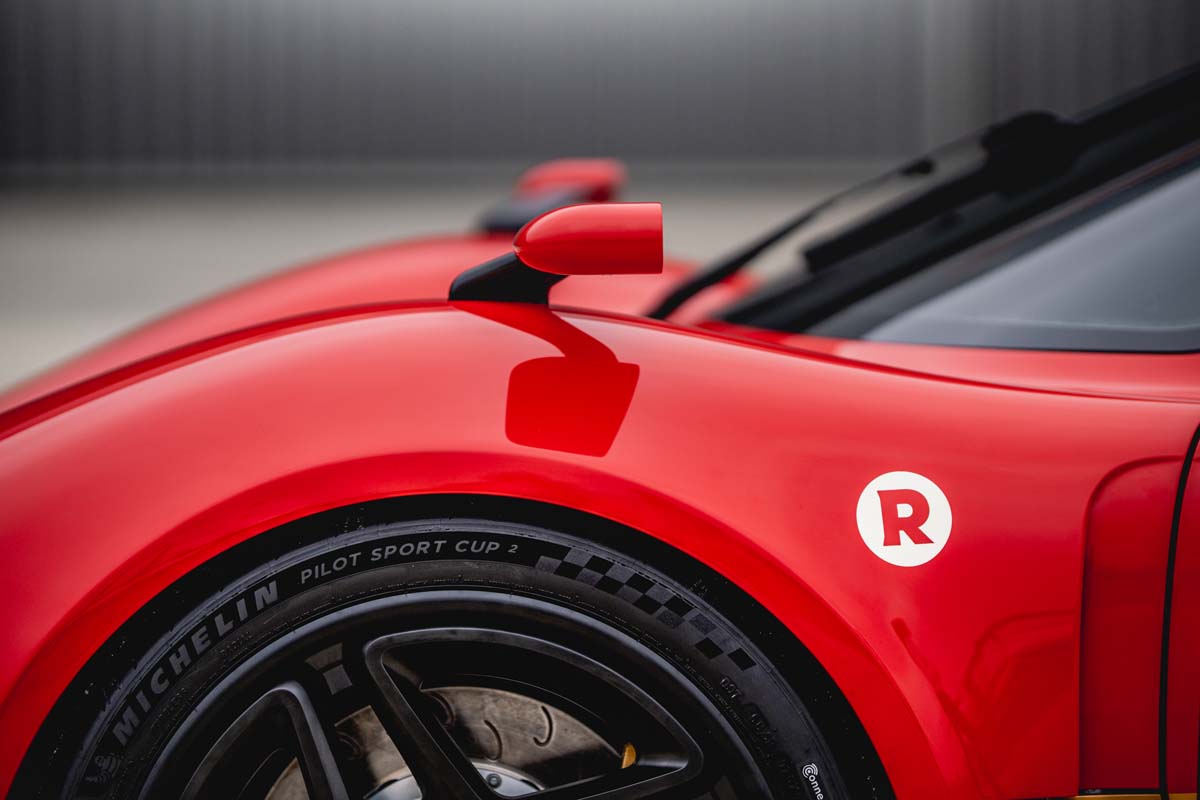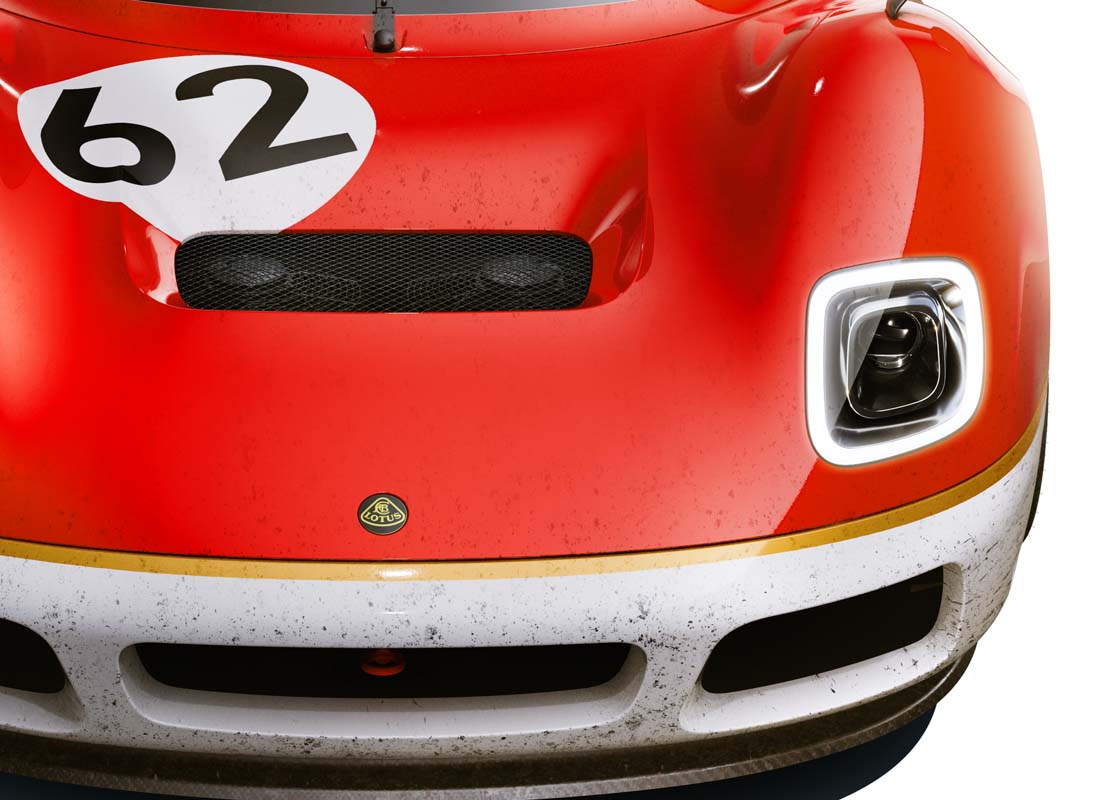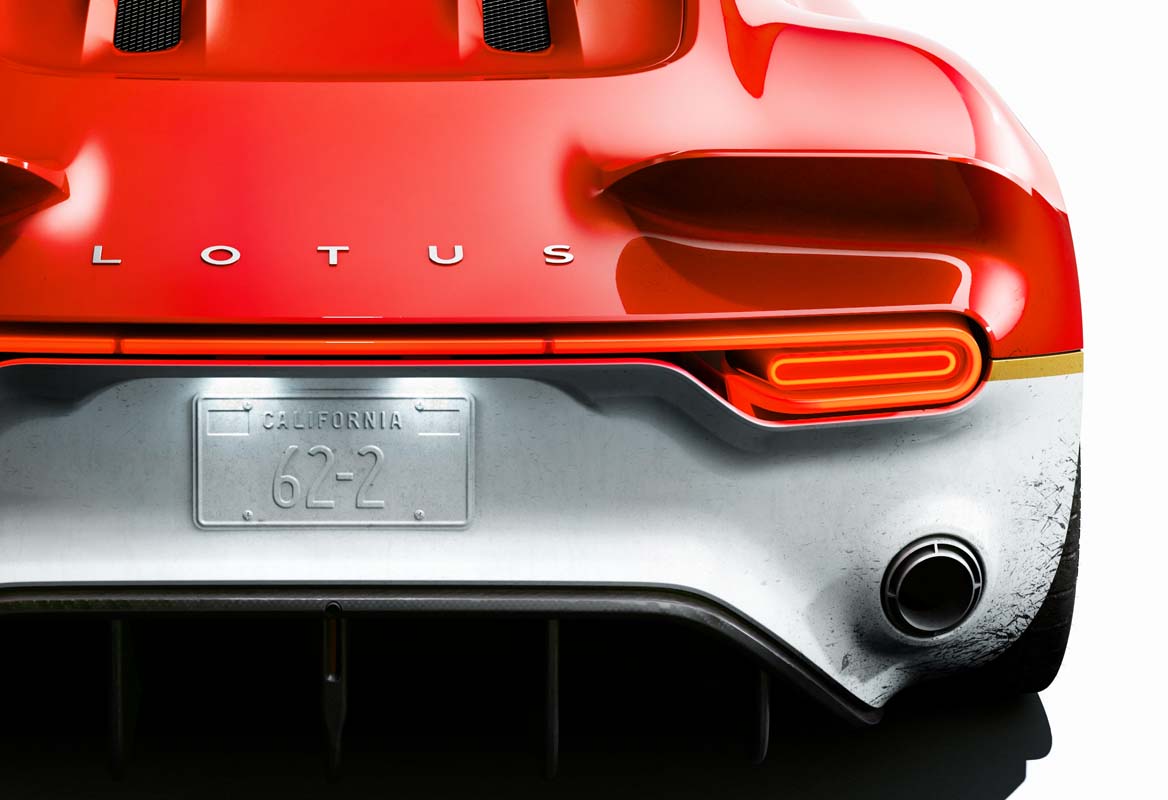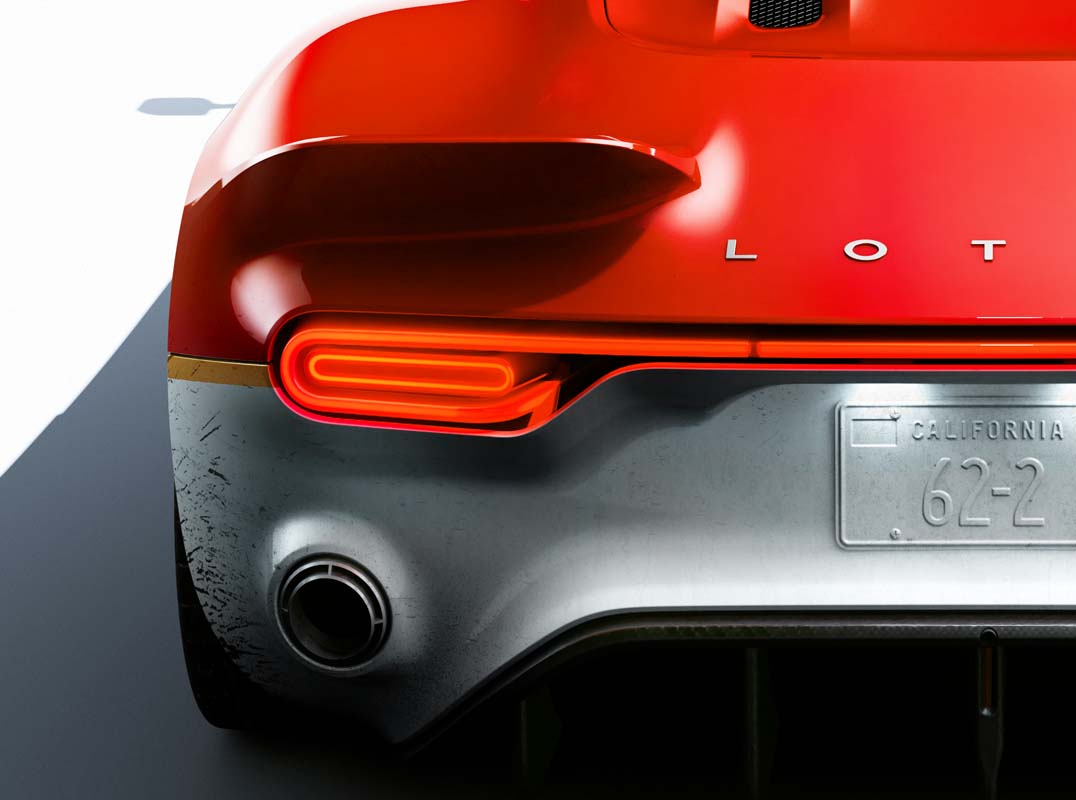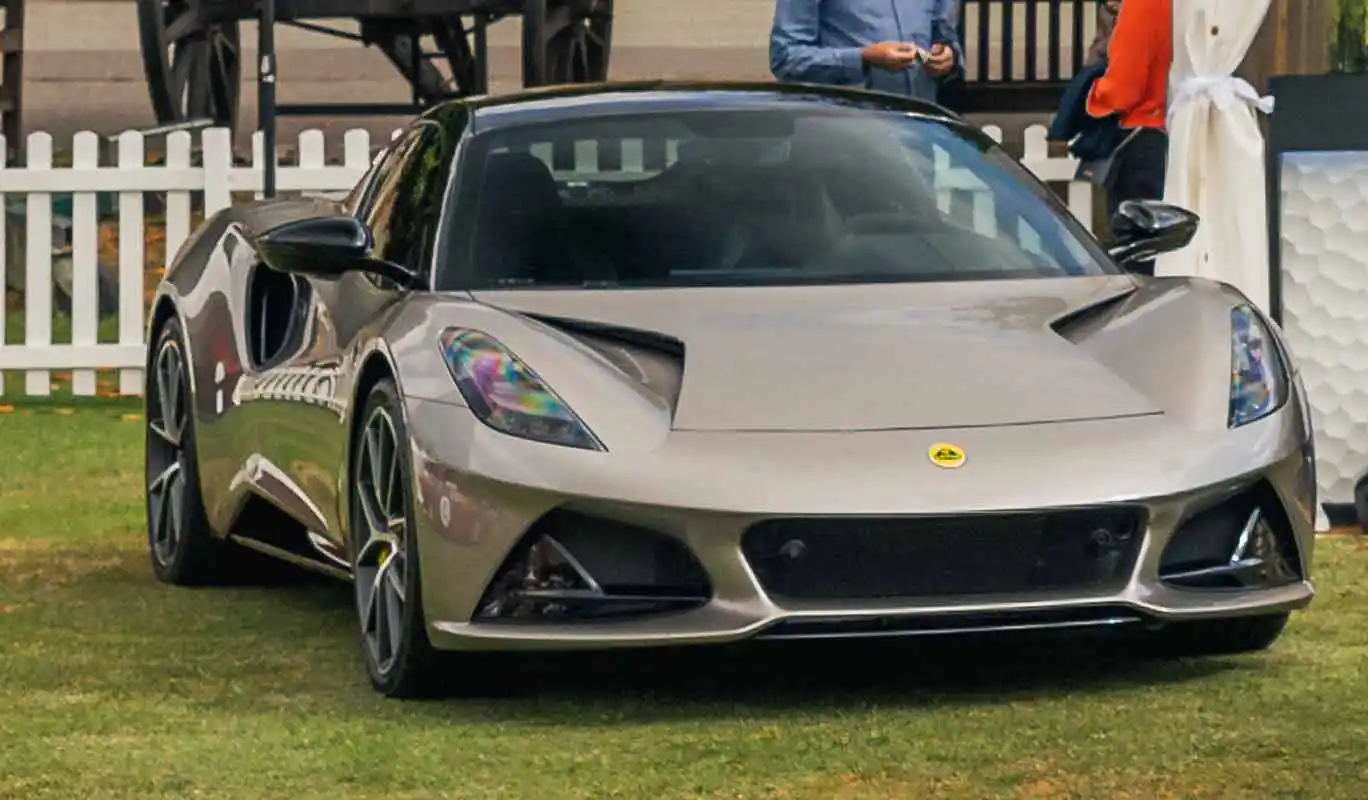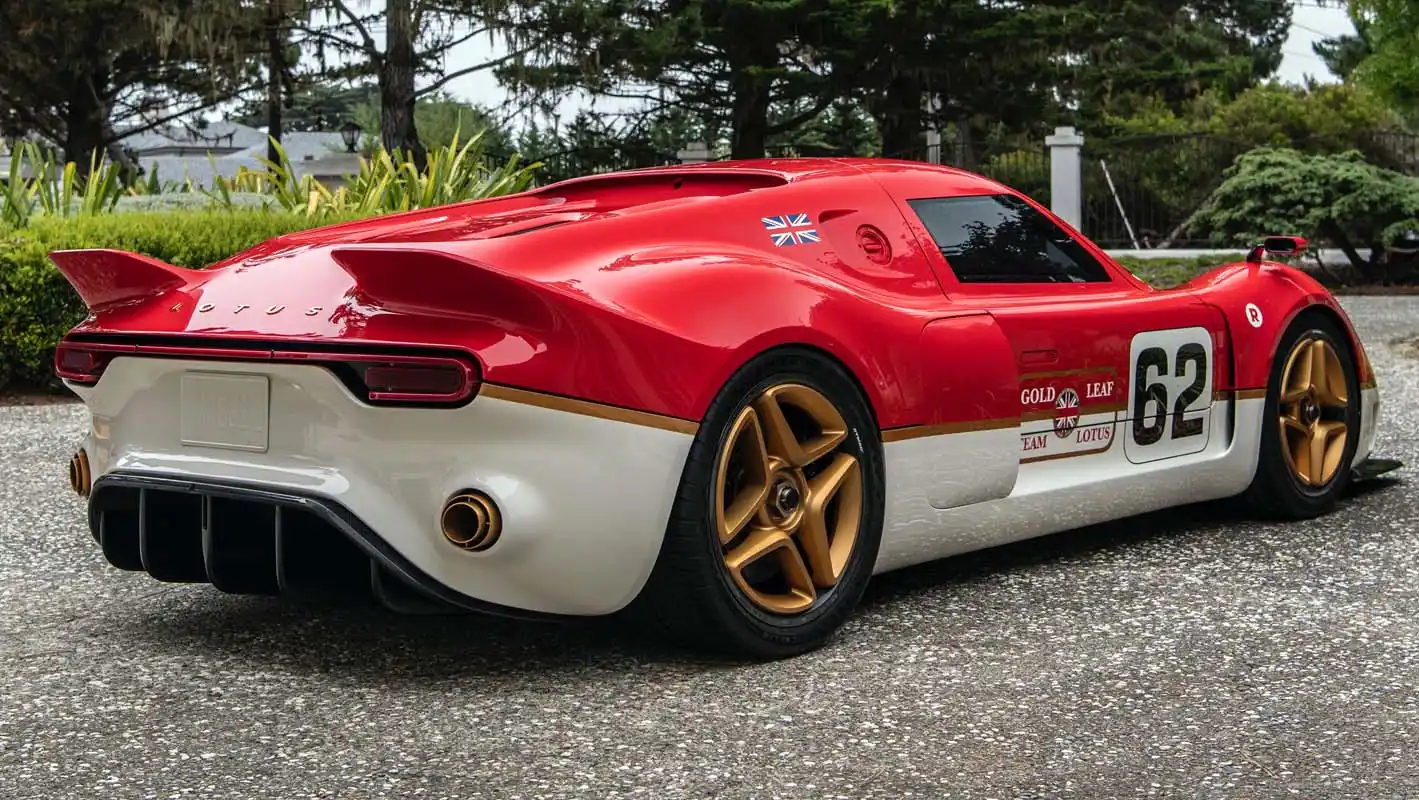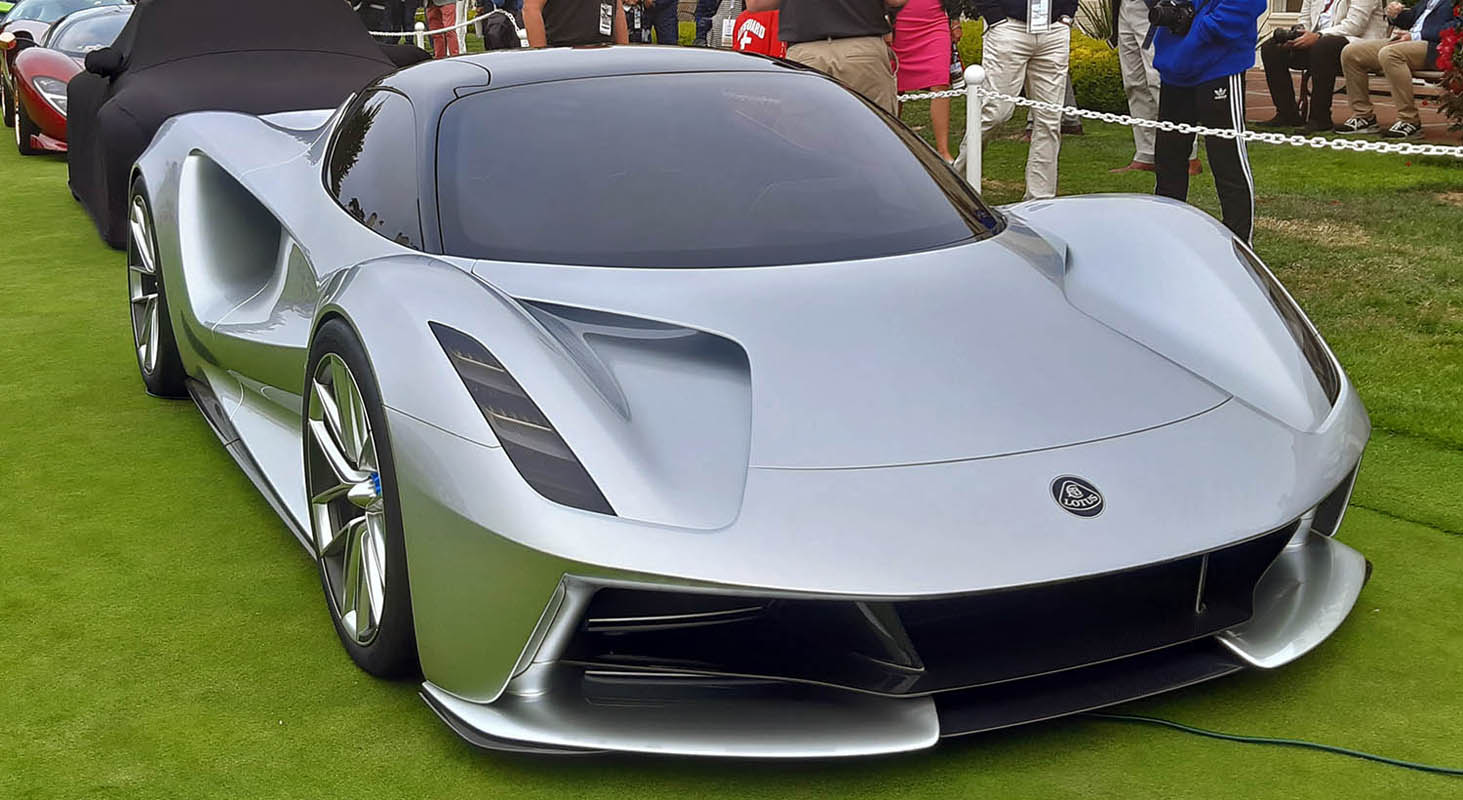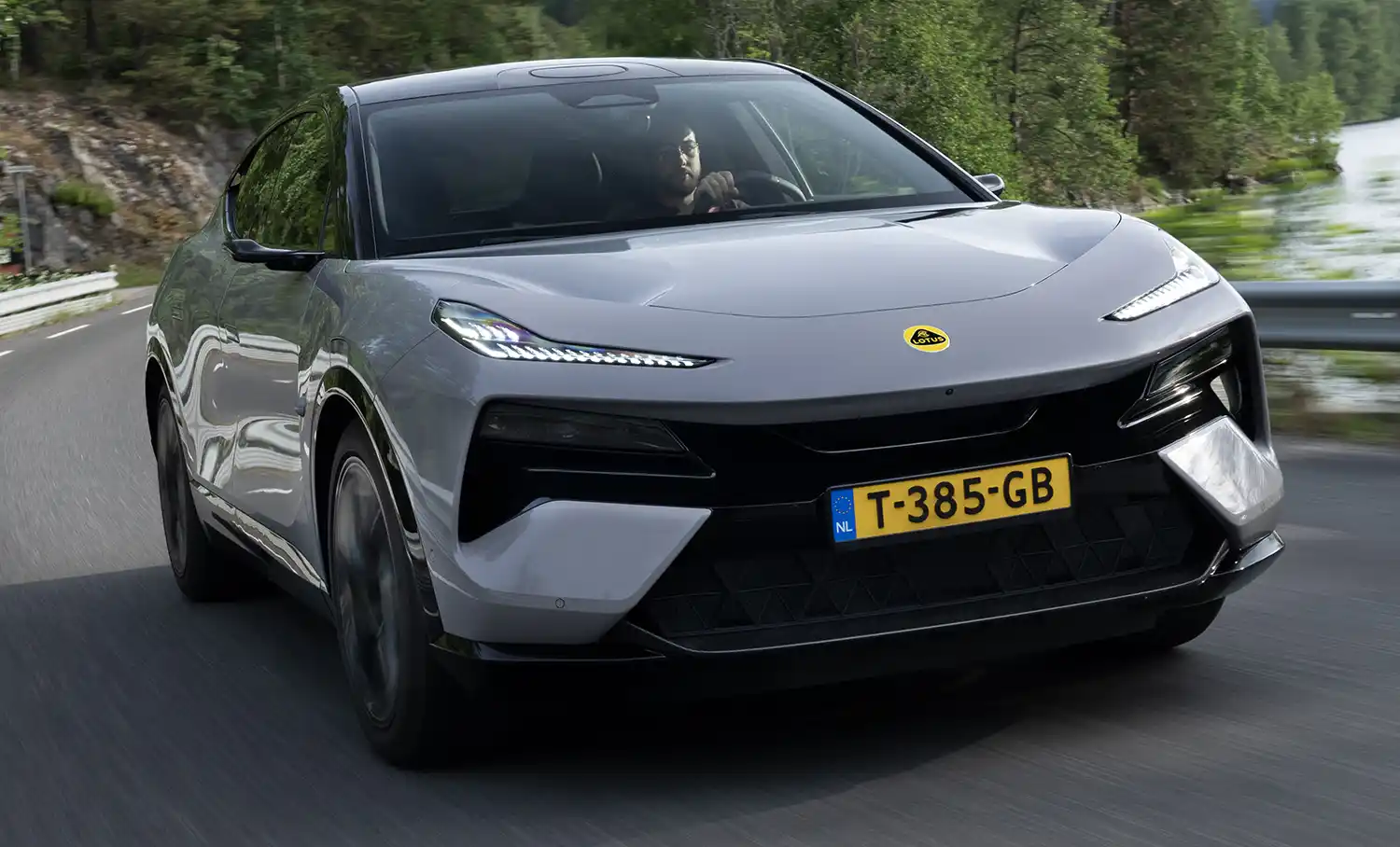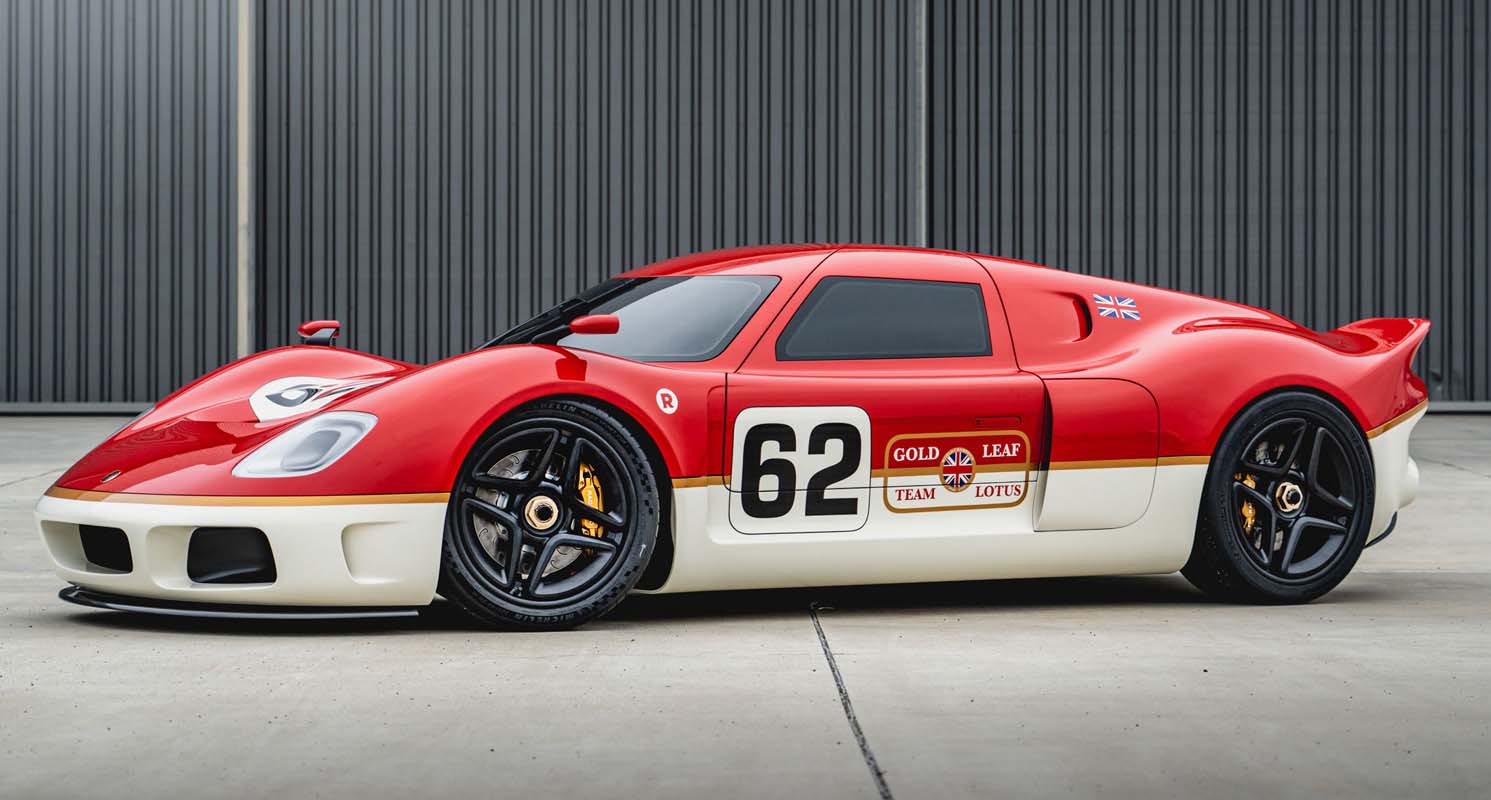
Radford has today unveiled the Type 62-2 sportscar at a star-studded event at the Lyon Air Museum in Orange County, California. The Lotus Type 62-2 coachbuilt by Radford (The Type 62-2), the first modern coachbuilt Radford, is limited to just 62 examples worldwide, with each model built precisely to its individual owner’s desired specification – the marque is currently accepting applications for build slots for the ultra-rare coachbuilt car.
Radford was borne out of inspiration by the legendary British coachbuilding company of the same name, which once built cars for a celebrity clientele that included all four of The Beatles. The global company with British heart and soul is co-owned by leading designer Mark Stubbs, broadcaster and motoring specialist Ant Anstead, former FIA Formula OneTM World Champion, Jenson Button and acclaimed business adviser and lawyer Roger Behle.
Radford’s first new model of the modern era is built in a partnership with Lotus. While the mid-engine two-seater coupé takes inspiration from the revered 1960’s Lotus Type 62, it utilises the Hethel marque’s latest technologies to deliver the purest possible driving experience. The Radford Type 62-2 is engineered for an unadulterated mechanical feel, exceptional engagement and uncompromising poise.
The global premiere is the first time the elegant lines of the exterior have been shown, and the highly luxurious interior will be revealed at a future date. The car’s design has been led by preeminent automotive designer Mark Stubbs who has taken the project from a sketch to the production-ready car revealed today. Stubbs’ design for the Type 62-2 evokes the spirit of Lotus and the original Type 62 as a homage to the marque’s illustrious motorsport history. With support from Radford’s engineers, former FIA Formula OneTM World Champion Jenson Button has fine-honed the dynamic response of the Type 62-2 to ensure a superlative driving experience.
Ant Anstead: “When you look at Lotus models from 1948 to today, each of them is numbered from Type 1 right up to the current day, our car is part of that historical lineage, meaning it will take its place in the history books forever. Only 62 Radford Type 62 models will ever be built. No two will be exactly alike, and each will be an exceptionally rare sight on the world’s roads.”
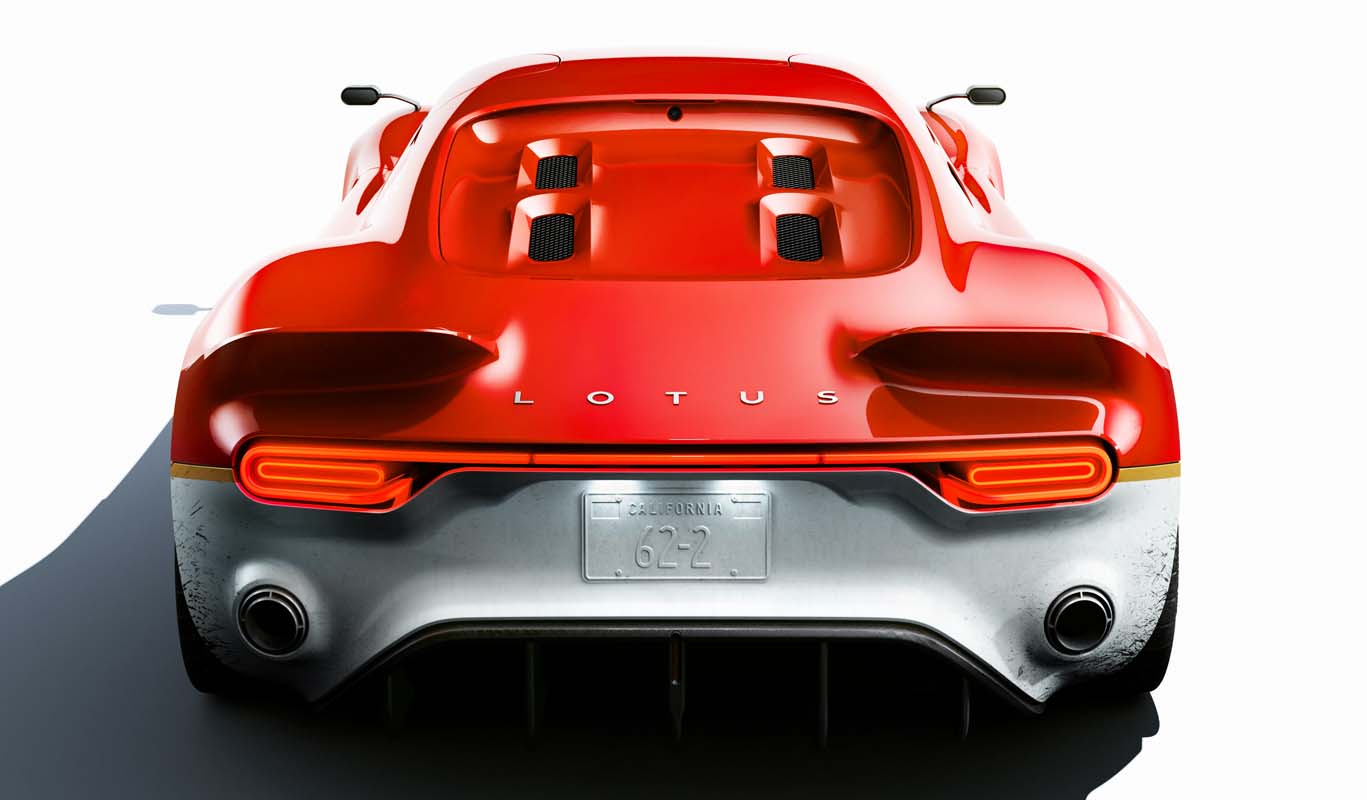
Design – a coachbuilt homage to a racing car icon from the 1960s
Mark Stubbs: “Coachbuilding in the modern era utterly liberates an automotive designer. Advances in technology have ushered in a new era of this historic craft, making it possible to achieve levels of quality and design never before possible and deliver them in an extremely short time. This enables us to evoke the spirit of an iconic car with stunning authenticity and offer owners the ultimate in customisation. However, while Type 62-2 elicits the original Type 62 Lotus hallmarks, it sets its own path as a Radford model – it’s all about creating a feeling of driving something timeless. Something that doesn’t look or feel like anything else on the road.”
The Type 62-2 offers design simplicity combined with a classic flair. The exterior provides the theatre and drama becoming of a luxurious, low-volume coachbuilt car – and the lines which evoke the original 1960s Lotus race car ensure exceptional elegance.
The most striking characteristics of the Type 62-2 exterior design are arguably its ground-hugging stance, low height at just 1,133mm, voluptuous wheel arches, striking side air intakes, distinctive double rear ducktails and doors which cut into the roofline and form part of the roof structure. The sensuous, uncluttered nature of the body surfaces are enabled by the car’s flat underbody and diffuser. These provide exceptional downforce, negating the need for a plethora of ungainly aerodynamic appendages, resulting in deliberately simple, smooth-flowing, achingly beautiful lines and a timeless, coachbuilt appearance.
The car’s side profile remains unerringly faithful to the original, displaying the signature curvaceous high wheel arches and low roofline. Slimline side windows add to the visual drama, as do the cooling ducts, which channel air rearwards to the mid-mounted engine.
At launch, Radford will introduce two versions of the Type 62-2. A ‘Classic’ version, with subtle design cues to the original Type 62 Lotus car which was designed without a wing, and a ‘Gold Leaf’ version, which pays homage to the race car’s iconic livery and distinctive wings added by Lotus in period for more downforce after track testing. Both cars beautifully encapsulate the quality and attention to detail that the Radford brand embodies. On the Classic Type 62-2, five-stud 17-inch forged aluminium wheels are fitted at the front and 18-inch wheels at the rear. On the Gold Leaf model, the wheels are two-piece aluminium 18-inch wheels at the front and 19-inch at the rear, with optional period centre-lock fixings available to further enhance the car’s historic racing style.
At the front, the clamshell sits low to the ground with a central air intake and two side apertures to ensure optimum cooling and airflow. The front wheel arches dominate the forward aspect, reaching high above the lower line of the windscreen and providing a driver’s eye view akin to that found in a 1970s Le Mans race car. A bonded flush cadet-style wrap-around windscreen and a single central wiper blade complete the period endurance-racer look.
Emanating from the tops of the two curvaceous arches are the slimline aerodynamic carbon composite wing mirrors with embedded camera technology. Angular LED headlights sit flush into the bodywork, and Daytime Running Lights within the lighting units create a distinctive light signature.
Along the side of the car, subtle side vents highlight the ‘form follows function’ nature of the Type 62-2, channelling air in towards the radiators while providing yet more excitement to the design. From this view, the doors are clearly visible, the tops of which extend into the car’s roof. This feature provides easier ingress and egress and gives a subtle nod to Radford’s involvement with the prototype Ford GT40 Le Mans car back in the 1960s, as the company helped fashion that car’s doors, rear engine hatch and front nosepiece.
At the rear of the Gold Leaf Type 62-2, the double ducktail spoiler is immediately visible, with the iconic Lotus lettering visible between the double ducktail spoilers. On the Classic Type 62-2 model, the ducktails are omitted in favour of a more subtle curvature to the rear end, this is also an homage to the original car which was designed without wings. On the original Lotus Type 62, the wings were added later after initial track testing, to provide the car with additional downforce.
Below sit distinctive rear light units, which hark back to the small square light clusters of the original Type 62. A smooth line connects the two rear light units, providing a more modern light signature and visually widening the car’s rear. The light cluster uses LEDs, which blink to indicate when the vehicle is turning left or right.
The rear is finished by two symmetrical wide-bore ceramic coated exhaust pipe tips. Underneath the exhausts, the bodywork kinks upwards above a deep diffuser which starts as a flat floor right from the front of the car, emanating at the rear, providing downforce and enhancing rear cornering grip.
Above the ducktail rear spoilers on top of the engine bay sits a beautifully crafted carbon fibre panel. Four ‘pill-shaped’ cut-outs – reminiscent of the Lotus Europa – provide another subtle nod to the car’s heritage while also serving a cooling function.
Mark Stubbs: “In many ways, it’s a real challenge creating a tribute to a historic vehicle – because nothing is quite the same as on a contemporary car. Inherently, the wheels are bigger, the overhangs are longer, and the cockpit and engine position are different. The Radford Type 62-2 was always intended as a homage, not a copy – to deliver that successfully means translating the essence of the original Type 62 into the modern world – which is something that I am confident we’ve achieved with the first Radford of the new era.”

Chassis and body – an uncompromising combination of carbon composite and aluminium for optimum lightness
The chassis and body of the Type 62-2 are constructed from high-quality bonded and riveted aluminium and premium-grade carbon fibre composite, respectively. This choice of advanced lightweight materials ensures inherent stiffness and gives a dry weight, for the race specification Type 62-2s, of under 1,000kgs. At the core of the Type 62-2 is a light aluminium monocoque structure. Formed with pioneering bonding techniques, the construction ensures exceptional torsional rigidity, which benefits handling and agility and enhances ride comfort.
The integrity of the lightweight bonded and riveted aluminium structure of Type 62-2’s chassis also ensures impressive occupant safety in the event of a crash. Its exceptional rigidity and torsional strength lower the need for additional bracing within the cabin – leaving the interior uncluttered and leading to further weight savings.
Adjoining the aluminium chassis is a carbon fibre composite structure that is inserted into the chassis. This incorporates the firewall, windscreen and roof structure of the car – effectively creating the structure of the car’s passenger cell. The design is incredibly rigid and contains a carbon composite roll hoop to offer occupant protection in the event of an accident.
The exterior body panels are crafted from carbon fibre composite – these include the front clam, the doors, the wheel arches, and all of the car’s rear panels, including the distinctive cover above the engine bay and the double rear ducktails.
The Radford chassis also employs a sophisticated tubular rear subframe, bespoke made by the company to increase strength, stiffness and cornering performance. Finished to impeccable standards, it provides further exemplary aesthetic values in areas where the rear subframe is visible.
Jenson Button: “Creating a car that is simultaneously luxurious and comfortable, and great to drive, is a tough challenge, but the first Radford of the modern era delivers. Type 62-2 is a driver’s car at its heart – when you see the design, it looks just like a 70s Le Mans car. And when you sit behind the steering wheel and look through the curved windscreen, you can see the front wheel arches – something you just don’t experience on road cars today. With such a low centre of gravity, the car’s body doesn’t roll. The chassis exhibits all the hallmarks of a beautifully set up race car for the road – gifting the driver supreme confidence to extract maximum enjoyment every journey.”
Performance – intoxicating power from a 3.5-litre supercharged V6 engine
The Radford Type 62-2 is powered by a 3.5-litre supercharged V6 engine. Adhering to Lotus race and road car philosophy, it is mid-mounted low to the car’s unique tubular rear subframe behind the driver, delivering an optimum centre of gravity and exemplary road holding.
During gentle driving, the engine is quiet and composed, endowing the Type 62-2 with consummate long-distance touring prowess. But when the driver presses the accelerator harder, the supercharged V6 engine takes on an altogether different character, responding instantly with a tractable, linear power delivery that ensures aggressive, supercar acceleration.
The engine in the Classic Type 62-2 musters 430bhp of power, and with a predicted dry weight of under 1,000 kilos, the car will produce an impressive power-to-weight ratio in the region of 430bhp per tonne – which is comparable to many modern supercars.
The engine in the Gold Leaf version offers even more outstanding performance. It features upgraded pistons, con-rods, camshafts and uprated electronic mapping to cope with the additional power and torque. In this form, it produces 500bhp, and with the same predicted weight as the Classic, the Gold Leaf’s power-to-weight ratio increases to an exceptional 500bhp per tonne. On all models, a bespoke titanium exhaust system delivers a genuinely impressive aural experience.
Jenson Button: “The sound of the Type 62-2 even at idle is something really special. But when you begin to explore the rev range further up, it becomes incredible, raising the hairs on the back of your neck and putting a big smile on your face. However, the unique thing about this engine is that we’ve kept it pure, no exhaust valves, no trickery of any kind – what you hear is uncorrupted and utterly authentic – just like every single element of the driving experience.”

Transmission – six-speed manual or seven-speed dual-clutch
The Type 62-2 is offered with either a six-speed manual gearbox or a seven-speed dual-clutch transmission (DCT). The Classic Type 62-2 is fitted with a close-ratio six-speed manual transmission and an electronic differential lock as standard, with a precision shift mechanism providing extremely slick shifts and a highly engaging, driver-focussed feel. Owners can also specify the Classic model with the DCT transmission as an option and have the V6 engine’s power output upgraded to 500bhp if they wish.
The Gold Leaf’s dual-clutch, seven-speed transmission, which is mated to a limited-slip differential, offers even faster, more efficient gear changes. Drivers can choose to enjoy the precise and engaging change in manual mode or make more relaxing, smooth and effortless progress in auto mode.
To ensure optimum stopping power on both road and track, the Radford has equipped the Type 62-2 with a state-of-the-art braking system, featuring AP Racing 4-pot callipers with iron rotors.
Vehicle Dynamics – race car agility with long-distance comfort
Jenson Button “The Type 62-2 tips the scales at under 1,000kgs, making it extremely rare among modern sportscars. Its responses, low centre of gravity and handling make it feel like a race car, yet it is also smooth and compliant on the road. The experience of driving the car is really about fun, simplicity and inspiring driver confidence behind the wheel – but with the luxury appointments you would expect from a world-class coachbuilder.”
With the pedigree of Lotus technology underpinning the car and the expertise of Formula One World Champion Jenson Button setting up the dynamics to excel on both road and track, the Type 62-2 is a thoroughly engaging driver’s car. But that driving pleasure never comes at the expense of comfort.
The suspension takes the form of coilover springs with 4-way adjustable dampers front and rear, with an optional hydraulic nose lift system offered to deal with speed bumps in town and uneven road surfaces. The Radford Type 62-2 is lowered beyond traditional Lotus geometry to provide additional grip and a lower centre of gravity, which adds to the driver-focused feel of the car.
The Classic model is equipped with a switchable, multi-mode Bosch ESP system. In contrast, the Gold Leaf model features an even more advanced independently switchable motorsport-derived ABS and traction control system. To ensure ultimate levels of feel and feedback from tyres to the driver, the steering is an unassisted rack and pinion system.
Type 62-2 has been developed to provide a balanced drive and inspire confidence. Its suspension set-up pushes the boundaries, providing a driving feel that takes it far beyond the parameters of most modern road cars and into the realms of a true race car. Under the guidance of Jenson Button, the car has been set up on the Radford Track in Arizona initially to fine-tune the balance. Following the perfection of these settings, the car is undergoing a rigorous testing programme on-road to ensure that the track suspension configuration translates seamlessly to everyday driving conditions and to dial in the comfort and compliance required of a luxury road-going vehicle.
By calibrating the car personally, Jenson Button is aiming to make the Type 62-2 feel alive and ‘on its toes,’ resulting in a car with exceptional steering feel and driver feedback, whether on a British B-road, a highway or a fast-flowing circuit.

Practicality – a true driver’s car that can be used every day
The Type 62-2 is a labour of love for the entire Radford team. Every craftsperson working on the car has devoted their energy and passion to making the car a peerless proposition. As a result, the Type 62-2 is a car that can be used every day, by all types of drivers. The car’s clever door design which pays homage to the original Type-62 also incorporates part of the roof, and was chosen specifically to enhance the ease of ingress and egress. At the same time, the sill of the aluminium chassis sits low to the ground, and the flat cabin floor is free from obstructions across the width of the car.
Once inside, all-around visibility is highly impressive, particularly rearward visibility enhanced by pin-sharp rear-facing cameras which replace the traditional mirrors. The car’s narrow proportions mean that its footprint is relatively small, making it easy to park and place on narrow roads or in urban environments. The front and rear parking cameras also significantly aid this process.
Lifting the rear clamshell reveals the storage compartment located in front of the engine but behind the cockpit. Owners will have the option to specify bespoke Mason and Sons holdalls to maximise the luggage space. In any guise, however, luggage for two can be accommodated for road trips.
Ensuring comfort and practicality around town, with an optional lift for the front suspension available on the car, allowing it to easily clear speed bumps and other road furniture without damaging the car’s bodywork.
Technology – driver-focussed essentials, with minimal distractions
Whilst paying homage to the past, the Type 62-2 is equipped with the very latest automotive technology available. This approach is illustrated by the two wing mirrors, which, while visually referencing those found on the original car, feature compact yet powerful cameras mounted inside their housings. Inside the car, two small screens on each A-pillar display a live image from outside.
The rear-view mirror is also replaced by a camera, as no rear visibility would be possible with a conventional mirror – due to the solid rear panel. As the driver looks into the rear-view digital screen, they not only see a perfect view of the road behind but the rear wheel arches too, with a hint of the rear ducktail spoilers also just visible.
The cutting edge Kappa optronics rear view mirrors not only utilise the very latest automotive technology, providing drivers with a crystal clear view of the road ahead, they also dramatically improve the car’s aerodynamics, thanks to their diminutive size compared to standard mirrors.
All essential information is relayed to the diver via a high contrast 6″ TFT display mounted behind the steering wheel directly in the driver’s line of sight, it features a dash logger with Wi-Fi connectivity, 18 integrated LEDs and 14 digital switch inputs, which can be used for daily driving and customised to suit track days at the push of a button.
The car also incorporates the latest Bluetooth connectivity – connecting wirelessly to the driver’s phone to stream audio, which is played via a 5-speaker sound system
Owner experience – the ultimate service for the ultimate coachbuilt car
Type 62-2 owners receive a totally bespoke and customised service from the Radford team. This begins with the first expression of interest and continues throughout the purchase, custom design and manufacturing process. That same approach will continue for the duration of vehicle ownership – providing owners with complete reassurance that their car will be cared for throughout its lifetime. Globally, Type 62-2 owners will have access to a global service network catering for the sale and service of Radford models.
Owners will be kept fully informed during every step of their car’s development, provided with the first sight of vehicle designs, engineering milestones and project updates. Moving closer to the car’s start of production date, owners will be invited to ‘co-create’ their vehicle to their exacting vision, liaising with Radford’s bespoke designers to ensure an utterly unique, coachbuilt, custom finish. They will also have the option of visiting their car during the build process if they wish.
Radford’s bespoke coachbuilding extends to all aspects of the car. Radford will work with owners to ensure that each and every owner desire on the car is met, this ranges from all of the interior finishes and unique paint colours through each part of the car’s design which includes surface changes to the vehicle bodywork to the power and performance of the car. Every Radford is totally unique and built exclusively for each owner.
Owners can choose to collect their car from Radford’s California base, Radford’s test track, or indeed, have it delivered to them anywhere in the world. Following collection, owners will be offered tailored experiences to continually enhance their ownership of one of the world’s most unique coachbuilt sportscars.
Production of the Radford Type 62-2 begins in late 2021, with first deliveries being made in Q1 2022.

